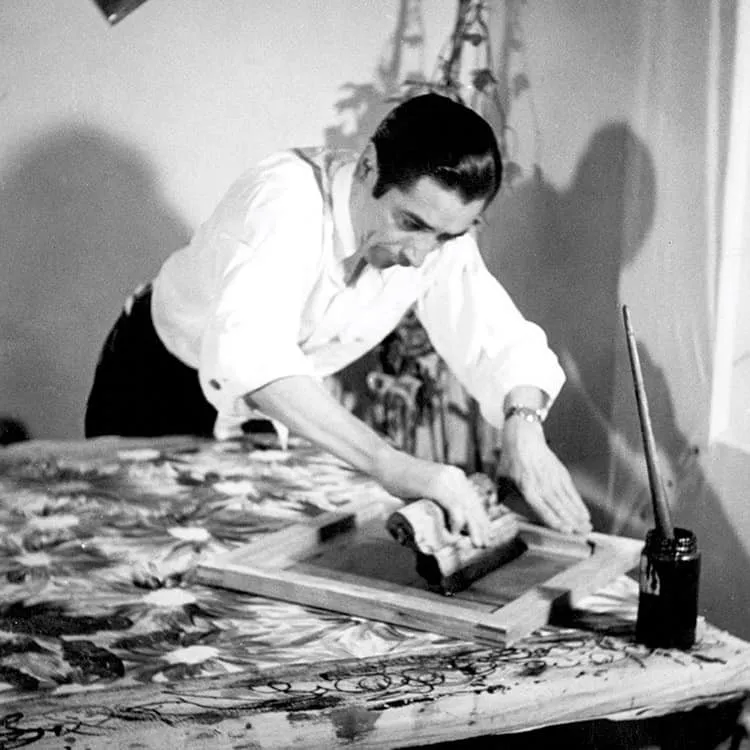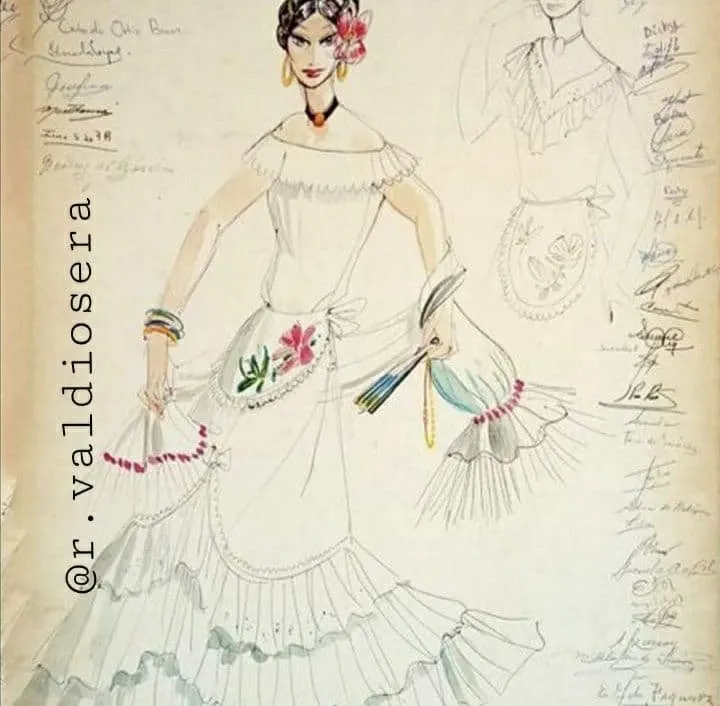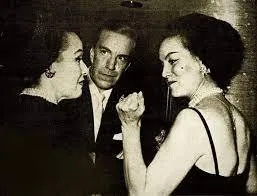Hello friends of Hive! Today I'm going to talk about the designers who were part of the golden age of Mexican cinema, those who dressed on and off the movie sets to all the movie stars, creating their own style so genuine, that many Mexican actresses and actors became true fashion icons. These designers through their garments created trends and left a legacy in the fashion and arts industry, not only in México, but worldwide. Let's begin:
1.-Armando Valdés Peza: born May 24, 1907, in México City was besides costume designer, actor and columnist, he wrote the section "Crónicas de México" of the newspaper El Universal where he made reviews of the events of the high society of Mexico.

Fuente
In 1942, he was hired to design the costumes for "Yo bailé con Don Porfirio" and only a few years later he was called to dress María Félix and Jorge Negrete in the films "El Peñón de las Ánimas" and "Enamorada". From then on, he became a personal friend of María Félix, in fact he traveled with María Félix on her European tour to have his creations always available.
In the early 1950s, Valdés Peza partnered with actress Rita Macedo to open a fashion house in Colonia Juárez in México City. Casa Valdés Peza dressed distinguished personalities of Mexican show business and society. He dressed celebrities such as Dolores del Río, Kitty de Hoyos, Columba Domínguez, Ana Luisa Peluffo, Miroslava, among other artists.
Valdés Peza was costume designer in around 100 films, among which are: Flor Silvestre, Río Escondido, Doña Diabla, Rumba Caliente, Aventura en Rio, Las Islas Marías, Un día de Vida , Cortesana and Diario de una mujer 1945.
Armando Valdés Peza, Died at his residence in México City on July 1, 1970.
2.-Ramón Valdiosera:
fashion designer, writer, painter, draftsman, historian, illustrator and collector. Born on (April 28, 1918 Ozuluama, Veracruz, México), he is known for being the creator of the Mexican pink, which he presented in a collection in New York in 1949, and showed his detractors that in México it was possible and fashionable. Virginia Pope, columnist for the New York Times, wrote about this collection: "that it was different from those commonly presented at the Hotel and that its creator had been inspired by the cultural past of his native land, where motifs from the Toltec and Mayan civilizations stand out... the collection was dazzling in color and unusual in design".

[Fuente] Instagram @r.valdiosera
In 1960 he partnered with an entrepreneur and created his commercial clothing line, called Maya Mexico, had 14 stores in Mexico and one in Beverly Hills. Dressing actresses like Yolanda Varela, Kitty de Hoyos, Blanca Estela Pavón, Virginia Serret, Elsa Aguirre, Ana Berta Lepe.
In 1961 the teacher Raul Pazzi Sequera took the initiative to commission the designer Ramon Valdiosera, who at that time was promoting the concept of a Mexican fashion based on elements and indigenous cultures to create the regional costume of the Huasteca Veracruzana, which was presented on April 30, 1961, at a gala ball in the Corona hall, where a parade of 80 costumes, which served as a preamble to the presentation of the prototype of the costume was presented.

[Fuente] Instagram @r.valdiosera
Valdiosera was the author of the book 3000 years of Mexican Fashion, which was the first fashion book in Mexico. In addition to other important titles such as: Mexican dances and Mexican types, among other books.
Some of the movies where he designed the costumes: Zonga, el ángel diabólico, Nos veremos en el cielo, La doncella de piedra, Chilam Balam, Cuando lloran los valientes.
Master Ramón Valdiosera was a faithful defender of the cultural richness of Mexico and its traditions, he died on April 11, 2017.
3.-Julio Chávez:
He was born in the State of Jalisco, in 1920. He arrived in Mexico in the 30's and in his beginnings he worked as a tailor and costume designer for the vedettes working in the marquees, revue theaters and cabarets of the city. In 1948 he designed the costumes for his first film and from then on his work did not stop appearing on the screens. Her creations were feminine, highlighting the waist; she designed the famous mermaid style dress popularized by Maria Victoria. In addition to the colorful dresses embroidered with rhinestones and beads and the tulle boa used by rumberas like Ninón Sevilla.

The designer dressed the biggest stars of show business, such as Sara Montiel, Lola Beltran, La Prieta Linda, Celia Cruz, Martha Roth, Lilia Prado, Ninon Sevilla, Maria Victoria, Columba Dominguez.

[Fuente] https://ks.com.mx/100-anos-de-julio-chavez/
He was designer and costume designer in more than 40 films including: Mi desconocida esposa, una gringuita en México, Mi querido Capitán, El diario de mi madre, La fuerza de los humildes, Pensión de artistas, Póker de reinas, En busca de un muro, Viva el Chubasco.
In 1977, she dressed the contestants of Señorita Mexico after appearing at Televisa's facilities to suggest her participation in the contest; later she participated as a dressmaker for the same program from 1981 to 1985.
In 1991 he published his autobiography "Vestidas y Desvestidas" in which he narrates his life and the show business environment of the Golden Age of Mexican cinema. he made his last dress to the vedette Anamía in 2003 and after a long career as a couturier he died at the age of 93 on December 21, 2013.
Emma Roldán:
Special mention for Doña Emma roldan, who besides being an actress, studied costume design in Paris, and was in charge of the wardrobe of many films, between the 1930s and 1940s. She was the first designer and costume designer to receive credit in this field in the sound era of cinema, for the costumes for Juárez and Maximiliano (Miguel Contreras Torres, 1933). Her creations for the characters of Maximiliano and Carlota were so popular that they were exhibited on wax mannequins during the premiere of the film in Mexico City. Among the films in which she participated as designer and costume designer were:
Ahí viene Vidal Tenorio (1948), Han matado a Tongolele (1948), La novia del mar (1947), Escuadrón 201 (1945), Cadetes de la naval (1945), San Francisco de Asís (1944), Sor Juana Inés de la Cruz (1935).

[Fuente]
https://twitter.com/raulbrindis/status/1092030035698114566
- raulbrindis
4.-Pedro Loredo:
Born in Mexico City on September 7, 1923, Loredo began his career as a watch salesman and in 1953 opened a workshop called "Fantasías" in the Colonia Centro of Mexico City. He was one of the first creators to show coordinated tailored suits, typical of the 1950s, but more feminine than was customary and with less rigid lapels.

Loredo often clarified that he had never studied fashion and that it was something he already had inside him: clearly his talent was innate, he was the first designer in Mexico who dared to design suits with transparencies at chest level and the entire length of the legs, many people criticized him for being vulgar and pornographic, while others celebrated his audacity.
In 1965 he participated in the International Fashion Week organized by the Mexican Fashion Institute, he presented a collection of swimsuits and transparent beachwear. The event was attended by designers such as Pierre Cardin, Manuel Pertegaz and Valentino who is said to have congratulated him for the innovation of total transparencies in skirts.
His designs and tunics always had pre-Hispanic motifs in canutillo, chaquira and embroidered sequins, which he often hand painted himself, giving a nationalistic touch to the costumes. He also made costumes for glamorous nights in chiffon with mint green, blue, red, yellow, black and white colors.
As for the wardrobe for film and television, his work stands out in films such as: La casa del farol rojo, La señora Muerte, Mariana, La muñeca perversa, Viva la parranda, Siete pecados.
Pedro Loredo died December 17, 2010.
5.-Manuel Méndez:
He was born in Mexico City on September 12, 1930, before dedicating himself to the world of fashion he worked in accounting, administration and public relations; but his aunt had a costume store which inspired him to dedicate himself to fashion design. In 1961, he founded his own fashion house and created more than 100 fashion collections for women of Mexican high society, from the arts to politics. Among his most recognized clients were María Félix, Dolores del Río, Silvia Pinal and Maricruz Olivier.

[Fuente] https://es.wikipedia.org/wiki/Manuel_M%C3%A9ndez_(dise%C3%B1ador)
In an interview she confessed that she began copying models from VOGUE magazine and it was not until 1968 that she presented her first collection.
In 1980 she presented her first collection in Paris with Mexican embroidery.
Costumes for film and television: Viviana, Panta rei, todo flúe and Días Azules.
He was known as the dean of Mexican fashion or the Mexican Balenciaga.
Manuel Méndez died on September 21, 2014.

